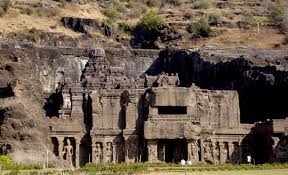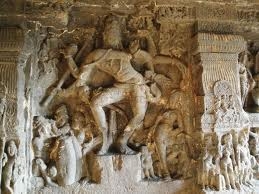








Ellora caves



pilgrimage
centers
Amarnath
Amritsar
Ayodhya
Badrinath
Bodha
Gaya
jyothirlingas
kanyakumari
Khajuraho
konark temple
Madurai
Mathura
Pandharpur
Pashupatinath
Puri Jagannath
Rameswaram
Rishikesh
Sarnath
Satya sai baba
Shani Shingnapur
Srikalahasti
Shri
Lakshmi GoldenTemple
Tirupathi
Vaishno Devi
SadGurus
Akkalkot
Maharaj
Shripad
SriVallabh
Dwadasa
jyotirlingas
Somanath
Shrishailam
Omkareshwar
Vaidyanath
Maha
Kaleshwar
Kashi
vishwanath
Bhimashankar
kedarnath
Nageshwer
Trimbakeshwar
Grishneshwar
Shakti
peethas
Sightseeing
Agra
Ajanta caves
Delhi
Ellora caves
Goa
Jaipur
Kashmir
Manasarovar
Foreign Trips









Cave 2 is also clearly inspired from Cave 1. Its doorways are
influenced from the many ancient temples found in India. The
ceiling is intricately designed and decorated exuberantly. The
walls inside have an image of a Thousand Buddhas, painted with
astonishing detailing. The corridor towards the right shows a
puerile girl on a swing – called the Woman on Swing – which
highlights Buddha’s thoughts that physical energy led to
illumination.
Cave 4 was made simultaneously with Cave 17, but was left
unfinished. There lie a huge number of incomplete paintings from
Buddha’s life. A crouching deer, dwarf musuician, and floral
plaster are some of the many things found in this
cave.
Cave 6 is representative of the Mahayana period. There lies an
image of a seated Buddha, surrounded by flying pairs of couples.
The pillars in these caves are much more fine than the earlier
caves and are in an octagonal shape. It has the painting of the
Bhikshu with Lotus.
Cave 9 accomodates the Chaitya Hall of Gathering. It has a Giant
Horseshoe Window. The Naga Worshippers and the Frieze of Animals
and Herdsmen are two paintings that can still be seen
there.
Cave 10 more or less resembles Cave 9 in its style and
architecture. You have the Shada-Dant Jataka – Buddha incarnated as
an elephant. There can also be seen the depiction of a King with
his Retinue and the Shyama Jataka. The Princess and Tusk and the
Buddha with the One-Eyed Monk are other two paintings that must be
checked out. Cave 11 is mainly concerned with indicating the shift
fro the Hinayana period to the Mahayana Period. It bares Buddhist
Stupas.
Cave 16 has a beautifully made porched doorway that lay the
foundation to the other doorways. This particular cave gives a
breathtaking view of the river beneath. This cave has the Giant
Buddha Statue, a depiction of Buddha with a Begging Bowl, the
Descent of Lord Buddha and Prince Siddhartha (Buddha) stretching a
bow. This cave is also home to the world famous art – Dying
Princess – that displays the princess’ shock when she gets to know
about her husband becoming a monk. The Sutasama Jataka is also
another sculpture that is a must watch.
Cave 17 shows paintings that symbolize love, like the Apsaras and
Flying Spirits and the Indra and the Apsaras. Apsaras mean Angels.
The Buddha Returns shows how Princess Siddhartha returned as a
beggar to reconcile with his wife and children.
Advertisement
I am a text block. Click on me to drag me around or click a corner handle to resize me. Click the settings icon (it's the left one, looks like a cog) to change this text. You can type new text into me or cut and paste text from somewhere else. Click outside of me when you're done and any changes will be saved.





Site designed and Maintained by Harish





